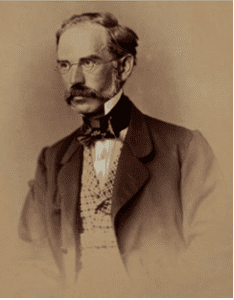
Vaclav Treitz (1819-1872) was born in Bohemia, studied humanities at the Charles University in Prague, and obtained his medical degree there in 1846. He then furthered his education at the New or Second Vienna School under the great luminaries of the time, Karl Rokitansky, Joseph Skoda, and Ferdinand von Hebra. He specifically worked in anatomy and pathology under Dr. Joseph Hyrtle, the popular teacher who in German countries was “the first to combine anatomy with clinical medicine.”1
After leaving Vienna, Treitz returned to Prague and worked for some time in solo practice and then as assistant in the university department of pathology. In 1851 he moved to Kraków, then part of the Austrian Empire, and became professor of pathological anatomy at the Jagiellonian University. It was during his three-year tenure there that he described the musculo-fibrous band that fixes the duodenum to the right crus of the diaphragm — later to called the ligament of Treitz. He also described several other structures in that area which bear his name, an arch and a fossa; and he studied similar musculo-fibrous arrangements in other organs, in the pharynx, the third layer of the stomach, the anal sphincter, the bladder, the urinary bladder, and the scrotum.
In 1855 Vaclav Treitz returned to a professorial position at the Charles University in Prague, and in 1858 was appointed Chair of Pathoanatomy. His most important work there was a treatise on internal retroperitoneal hernias, their location, and complications by strangulation. In 1859 he published his investigations of the gastro-intestinal lesions of uremia, claiming that the ammoniacal substances retained by the kidney exerted a corrosive effect on the mucosa of the gut. He was a popular teacher and was able to attract promising students.
As time went on, however, he became increasingly involved in controversies with other members of the faculty, some of whom he antagonized by supporting the observations of Ignaz Semmelweis on the causation of puerperal fever. He also maintained that the treatment of tuberculosis should consist of rest, not of increased activity as some of his colleagues prescribed. But above all Treitz was an ardent nationalist, opposed to the Austrian domination of his country and specifically to the attempts by the Austrian imperial bureaucracy to introduce German as the language in which lectures should be given. He became increasingly controversial and divisive, attacked, often in public, by the German faculty members of the university, and found himself excluded from the Viennese institutions and the mainstream of German medicine.1 He eventually developed a persecution complex, became isolated and depressed, and in 1872 committed suicide by taking potassium cyanide.
Reference:
- Fox RS, Fox CG, Graham WP. Vaclav Treitz (1819-1872): Czechoslovakian Pathoanatomist and Patriot. World J Surg.1983; 9:361.

Leave a Reply